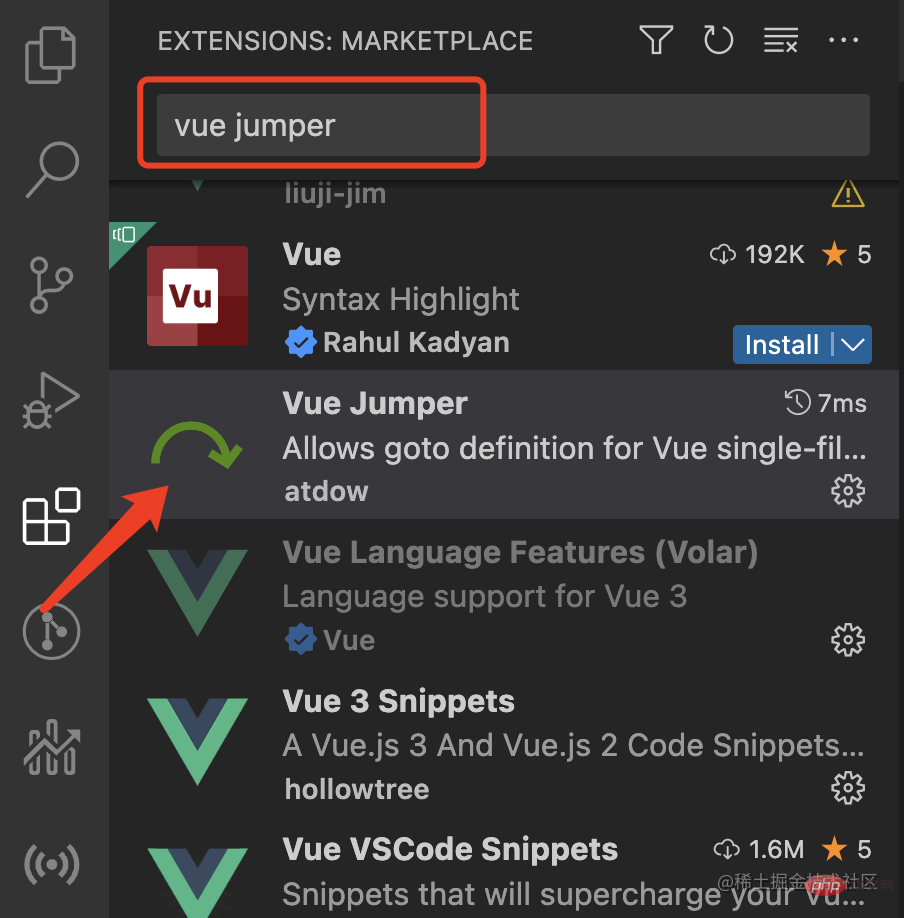 Development Tools
Development Tools
 VSCode
VSCode
 Practical combat: Develop a plug-in in vscode that supports vue files to jump to definitions
Practical combat: Develop a plug-in in vscode that supports vue files to jump to definitions
Practical combat: Develop a plug-in in vscode that supports vue files to jump to definitions

vscode itself supports vue file components to jump to definitions, but the support is very weak. Under the configuration of vue-cli, we can write many flexible usages, which can improve our production efficiency. But it is these flexible writing methods that prevent the functions provided by vscode itself from supporting jumping to file definitions. In order to be compatible with these flexible writing methods and improve work efficiency, I wrote a vscode plug-in that supports Vue files to jump to definitions. [Recommended learning: "vscode tutorial"]
plug-in
vscode supports vue files to jump to defined plug-ins (vue jumper ) has been officially released to the vscode plug-in market. You can go to the vscode plug-in market to download and experience it directly.

Function
This plug-in supports vue-cli to provide us with jump support for many component reference writing methods.
1. Omit writing jump support
When we reference a component, if the name of the component is index.vue or index.js, we can omit index.vue or index.js when introducing it. If we use the omitted writing method, vscode itself cannot support jumps, so the plug-in needs to support omitted writing method jumps.
import MycoMponent from '../components/MyComponent' // '../components/MyComponent/index.vue'
2. Alis alias path jump support
Under the configuration of vue-cli (webpack), we can configure alis alias so that we can improve production efficiency , but vscode itself does not support it, so the plug-in needs to support alis alias path jump.
import MycoMponent from '@/components/MyComponent'
3. Components registration alias jump support
vscode itself supports components registration alias jump (if the writing method and alis alias path are omitted when introducing, it will not work. supported), so the plug-in also needs to support components registration alias jump.
<script>
import MycoMponent from &#39;@/components/MyComponent&#39;
export default {
components: {
MycoMponentReName: MycoMponent
}
}
</script>4. Component jump support introduced in mixins
In actual development, we can have many reusable functions extracted tomixins contains the introduction and registration of components. This vscode itself does not support jumps, so the plug-in supports the introduction of mixins.
<template>
<MyComponent />
</template>
<script>
import myMixins from '@/mixins/myMixins'
export default {
mixins: [myMixins]
}
</script>// myMixins.js
import MycoMponent from '@/components/MyComponent'
export default {
components: {
MycoMponent
}
}5. Global components introduce jump support
For components registered globally, vscode itself does not support jumps in this case. Since the introduction of global components is relatively complex, the plug-in uses fuzzy search to find the place where the component is defined, and achieves jump support for the introduction of global components.
<template>
<MyComponent />
</template>
<script>// main.js import vue from 'vue' import MycoMponent from './components/MyComponent' vue.use(MycoMponent)
For more knowledge about VSCode, please visit: vscode Basic Tutorial!
The above is the detailed content of Practical combat: Develop a plug-in in vscode that supports vue files to jump to definitions. For more information, please follow other related articles on the PHP Chinese website!

Hot AI Tools

Undresser.AI Undress
AI-powered app for creating realistic nude photos

AI Clothes Remover
Online AI tool for removing clothes from photos.

Undress AI Tool
Undress images for free

Clothoff.io
AI clothes remover

AI Hentai Generator
Generate AI Hentai for free.

Hot Article

Hot Tools

Notepad++7.3.1
Easy-to-use and free code editor

SublimeText3 Chinese version
Chinese version, very easy to use

Zend Studio 13.0.1
Powerful PHP integrated development environment

Dreamweaver CS6
Visual web development tools

SublimeText3 Mac version
God-level code editing software (SublimeText3)

Hot Topics
 1376
1376
 52
52
 How to view word documents in vscode How to view word documents in vscode
May 09, 2024 am 09:37 AM
How to view word documents in vscode How to view word documents in vscode
May 09, 2024 am 09:37 AM
First, open the vscode software on the computer, click the [Extension] icon on the left, as shown in ① in the figure. Then, enter [officeviewer] in the search box of the extension interface, as shown in ② in the figure. Then, from the search Select [officeviewer] to install in the results, as shown in ③ in the figure. Finally, open the file, such as docx, pdf, etc., as shown below
 How to add files to vscode workspace How to add files to vscode workspace
May 09, 2024 am 09:43 AM
How to add files to vscode workspace How to add files to vscode workspace
May 09, 2024 am 09:43 AM
1. First, open the vscode software, click the explorer icon, and find the workspace window 2. Then, click the file menu in the upper left corner and find the add folder to workspace option 3. Finally, find the folder location in the local disk , click the add button
 How to enable background updates in vscode How to enable background updates in vscode
May 09, 2024 am 09:52 AM
How to enable background updates in vscode How to enable background updates in vscode
May 09, 2024 am 09:52 AM
1. First, after opening the interface, click the file menu in the upper left corner. 2. Then, click the settings button in the preferences column. 3. Then, in the settings page that jumps, find the update section. 4. Finally, click the mouse to check and enable it. Download and install the new VSCode version button in the background on Windows and restart the program.
 How to disable wsl configuration file in vscode How to disable wsl configuration file in vscode
May 09, 2024 am 10:30 AM
How to disable wsl configuration file in vscode How to disable wsl configuration file in vscode
May 09, 2024 am 10:30 AM
1. First, open the settings option in the settings menu. 2. Then, find the terminal column in the commonly used page. 3. Finally, uncheck the usewslprofiles button on the right side of the column.
 How to set animation smooth insertion in VScode VScode tutorial to set animation smooth insertion
May 09, 2024 am 09:49 AM
How to set animation smooth insertion in VScode VScode tutorial to set animation smooth insertion
May 09, 2024 am 09:49 AM
1. First, after opening the interface, click the workspace interface 2. Then, in the open editing panel, click the File menu 3. Then, click the Settings button under the Preferences column 4. Finally, click the mouse to check the CursorSmoothCaretAnimation button and save Just set it
 How to open workspace trust permissions in Vscode Vscode method to open workspace trust permissions
May 09, 2024 am 10:34 AM
How to open workspace trust permissions in Vscode Vscode method to open workspace trust permissions
May 09, 2024 am 10:34 AM
1. First, after opening the editing window, click the configuration icon in the lower left corner 2. Then, click the Manage Workspace Trust button in the submenu that opens 3. Then, find the page in the editing window 4. Finally, according to your office Just check the relevant instructions if required
 How to open animation in Vscode Introduction to the method of opening animation in Vscode
May 09, 2024 am 10:28 AM
How to open animation in Vscode Introduction to the method of opening animation in Vscode
May 09, 2024 am 10:28 AM
1. First, click to open the settings option in the More menu. 2. Then, find the terminal column under the Features section. 3. Finally, on the right side of the column, click the enableanimation button with the mouse and save the settings.
 How to turn on smart commit in vscode Steps to turn on smart commit in vscode
May 09, 2024 am 10:40 AM
How to turn on smart commit in vscode Steps to turn on smart commit in vscode
May 09, 2024 am 10:40 AM
Step 1: After opening the vscode software interface, click the settings button in the settings menu below. Step 2: Find the Git option under the Extensions column. Step 3: Click to check the enablesmartcommit button.



